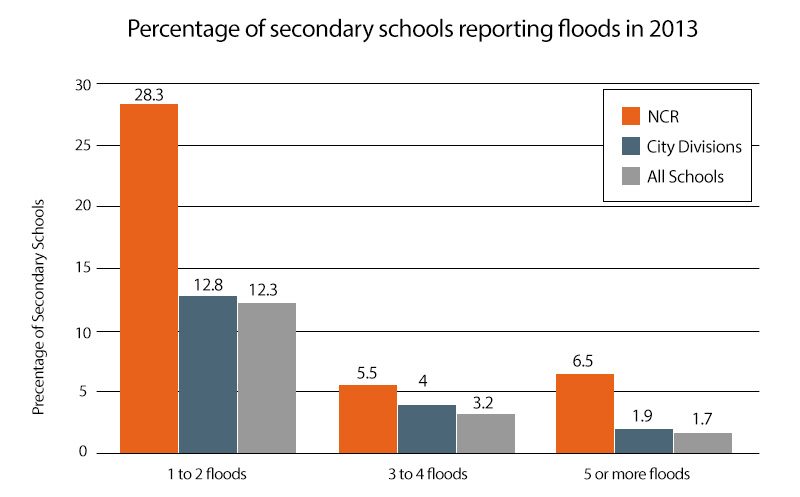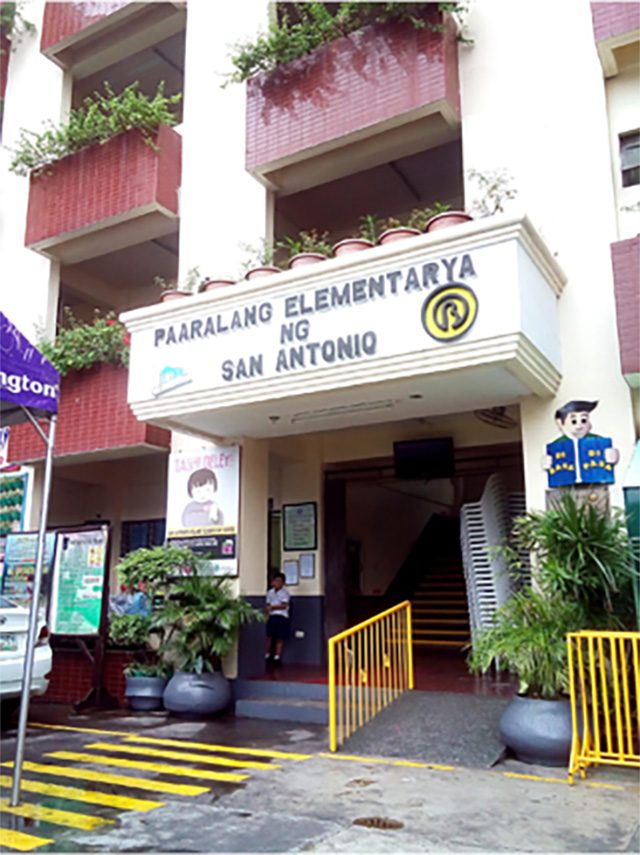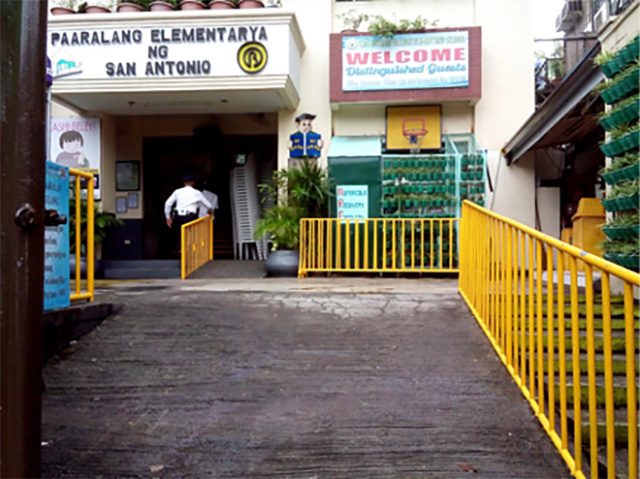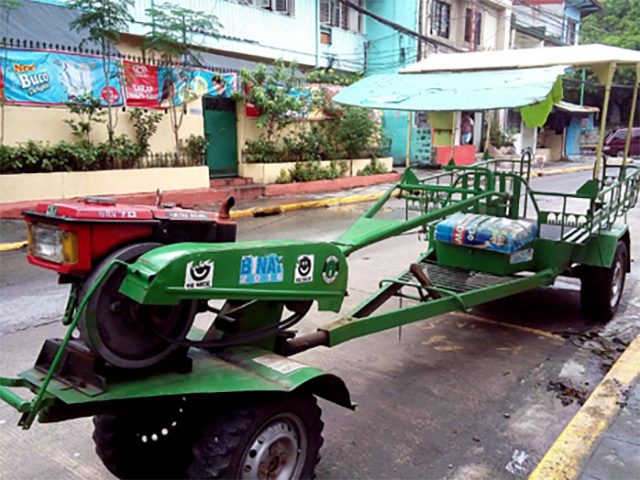SUMMARY
This is AI generated summarization, which may have errors. For context, always refer to the full article.

Our public schools are supposed to protect our children from the elements, from earthquakes, floods, or typhoons. June, when the school year begins, is also the beginning of the rainy season. School may often be cancelled because of typhoons and heavy rainfall that can quickly create floods around schools. In densely urban areas, streets can get flooded even at the slightest rainfall. Flooding in and around public schools is a constant hazard in the Philippines.
In 2013, according to DepEd data, 16.3% of elementary schools (that is, over 5,000 schools) were flooded at least once. Close to 5%, or 1,467 schools were flooded three or more times and 568 schools experienced 5 or more floods. Among public high schools 17.2% were flooded at least once.
Philippine schools are used to getting flooded periodically during a year. In National Capital Region (NCR), 42.4% of elementary schools and 40.3% of high schools experienced floods at least once in 2013. For some of these schools, the flooding presents challenges on different fronts.

Coping with constant floods
San Antonio Village Elementary School in Makati City is located in one of the most flood-prone barangays in the city, San Antonio. The school had 6 flooding incidents in 2013. Since assuming her position in June 2016 just this school year, the principal Mrs. Romela Sanchez has already seen 5 instances of flooding in the neighboring area. It is so common that both parents and schoolchildren know what to do during floods, “Sanay na sanay na naman [ang] mga magulang at bata. Alam na nila gagawin.” (Parents and children are used to the floods. They already know what to do.)

Juan Luna Elementary School, located in Sampaloc, Manila near España Avenue, is surrounded by flood-prone streets. During heavy rainfall, streets near the school get flooded and students have a hard time getting to school. “Apektado, di pumapasok ang mga bata. Kasi hanggang kalahati pa-tuhod yung tubig eh,” (School’s affected, children don’t go to school, because the floods are halfway up to the knees) principal Dr. Miriam Collantes explains. Some parents would have to spend extra money to hire a pedicab so their children can safely get to class.
Principal Sanchez does not think that flooding directly affects the student’s performance. Despite getting flooded many times in a year, San Antonio Village Elementary School is one of the top performing elementary schools in NCR. In fact, in the National Achievement Test (NAT) for Grade 6, the school consistently ranked first in its division for years 2012, 2013, and 2014. It ranked 10th in NCR in 2012, sixth in 2013, and second in 2014.
Principal Collantes explains that although class suspensions resulting from floods affect the classes, teachers conduct make-up classes to catch up with the lessons. “Apektado talaga kasi yung mga skills na para sa araw na iyon, hindi na naituro. Pero ang mga guro ko naman, may contingency plan yan. Kung hindi nila naituro, may make-up class,” she says.
(It’s really affected because the skills set to be taught on that day end up not being taught. However, teachers have a contingency plan for that. They usually conduct make-up classes.)
Schools have grown resilient against regular flooding by devising ways to make up for lost school days. Compared to the rest of the country, NCR schools are more likely to get flooded. When examined against school performance, you will find that high schools reporting more floods have higher test scores, suggesting that schools get used to the conditions. They devised ways to work around hazards that occur with regularity.
Regardless of their impacts on test scores however, flooding remains a hazard to student and parent safety. When floodwaters take time to recede, students have to wade through muddy water. Standing water becomes breeding grounds for mosquitos. Surfaces where children walk become slippery and dangerous to navigate.
What is being done and what can be done?
It is no accident that there are schools prone to flooding. There is a systemic issue to some of this. Many public schools are built on land that is donated or purchased by LGUs on behalf of the schools. In urban areas, land is expensive so schools end up being built on land that is of low value, land that is flood-prone to begin with. On this score, LGUs have a critical role to play in planning land use and understanding hazards to craft effective intervention.
School buildings in flood-prone areas are usually built on top of elevated floors so that flood waters would not reach the classrooms. Such is the case of the four-story building of San Antonio Village Elementary School, built in 1991. Despite the building’s elevation, there are still times when flood waters would reach the school. Mr. Sherwin Dulay, the school’s physical facilities coordinator, recalled that floodwater entered the school during Habagat in 2013.

Schools usually have systems in place in case of floods. In the case of San Antonio Village Elementary School, the coordinator monitors the situation outside the school during heavy rainfall and he reports to the principal. The principal has the authority to suspend classes, even before the announcements of DepEd and the city mayor. If the suspension happens after all the students are already inside the premises of the school and there’s a flood outside, the kids are kept inside the school until parents arrive. If floods have not subsided, barangay authorities lend motorized vehicles, called kuliglig, or their two speedboats to help transport the students, parents, and teachers to higher ground.

Schools also submit a strategic plan for disaster risk reduction and management to DepEd annually. In the case of long-term solutions to flooding, Dulay said that elevating the roads may not be a practical solution. “Hindi naman kasi practical yung sasabihin mong papataasan lang. Kung papataasin mo kasi yung kalsada, saan pupunta yung baha? Ang pinaka-maganda diyan, ayusin ang drainage palabas,” he said.
(It’s not practical to just elevate roads. If roads are elevated, where does the flood go? The best way is to repair the drainage going out.)
The rains will keep coming
Schools have to contend with floods on a regular basis, it is their job to keep small children safe and to protect their learning from potential negative impacts of having school days canceled. Long-term solutions are largely not within their control, because solutions to flooding in an area should be informed by responsible and competent land use and urban planning, which is a function of local governments. It must surely be a priority for these local governments to have long-term plans in place to protect our children from hazards presented by their environment. – Rappler.com
This analysis was supported by a research grant from the UP EIDR Grant C06-013. The authors thank DepEd for providing the data. The analyses contained and views expressed are of the authors alone and do not reflect the views of DepEd or UP.
Jenna Mae Atun is a lecturer at the Department of Communication at the Ateneo de Manila University where she teaches communication research. She is also pursuing a masters in Development Economics at the UP School of Economics.
Clarissa C. David is a Professor at the UP College of Mass Communication and a fellow of Social Weather Stations Inc. She is also the 2015 Outstanding Young Scientist awardee for social science.
Add a comment
How does this make you feel?
There are no comments yet. Add your comment to start the conversation.